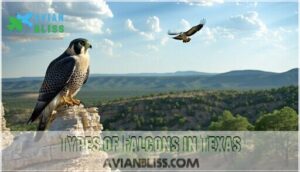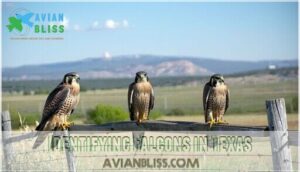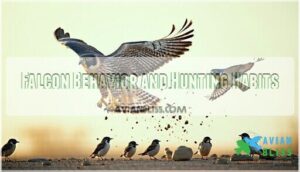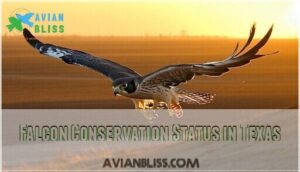This site is supported by our readers. We may earn a commission, at no cost to you, if you purchase through links.

These aerial hunters rule Texas skies year-round or sweep through during migration seasons. The American Kestrel and Peregrine Falcon call Texas home permanently, while species like the Merlin and Prairie Falcon visit during their seasonal journeys.
Texas’s diverse landscapes – coastal plains, hill country, and desert regions – create perfect hunting grounds for these raptors. Each falcon species has adapted to specific habitats and prey preferences, making the Lone Star State a premier destination for falcon watching.
The key lies in knowing where and when to look for each species, as this knowledge can help you spot these amazing birds in their natural habitats, and understand the importance of Texas’s landscapes as perfect hunting grounds.
Table Of Contents
- Key Takeaways
- Types of Falcons in Texas
- Falcon Distribution Across Texas
- Seasonal Falcon Migration in Texas
- Identifying Falcons in Texas
- Falcon Behavior and Hunting Habits
- Falcon Conservation Status in Texas
- Falcon Species Profiles
- Falcons in Urban Environments
- Falcon Diet and Foraging Habits
- Falcons in Texas Ecosystems
- Frequently Asked Questions (FAQs)
- How can you tell a hawk from a falcon?
- What do hawks in Texas look like?
- What is the smallest falcon in Texas?
- Is there a Cooper’s Hawk in Texas?
- What is the lifespan of falcons in Texas?
- How do falcons interact with other birds in Texas?
- Do falcons face threats from predators in Texas?
- What role do falcons play in local culture?
- How do Texan weather patterns affect falcon behavior?
- How long do falcons live in Texas?
- Conclusion
Key Takeaways
- You’ll encounter ten distinct falcon species in Texas, ranging from the tiny 9-inch American Kestrel to the powerful 25-inch Crested Caracara, with some living year-round while others migrate through seasonally.
- You can identify Texas falcons by their pointed wings, curved beaks, and unique plumage patterns like the American Kestrel’s rusty-red coloring or the Peregrine Falcon’s distinctive "tear marks" below their eyes.
- You’ll find falcons thriving in diverse Texas habitats from urban skyscrapers where Peregrine Falcons nest on tall buildings to coastal areas that attract winter migrants and grasslands where reintroduced Aplomado Falcons hunt cooperatively.
- You’re witnessing remarkable conservation success stories in Texas, particularly with Peregrine Falcons recovering from near-extinction and ongoing Aplomado Falcon reintroduction programs that’ve established breeding populations in South Texas.
Types of Falcons in Texas
You’ll encounter several distinct falcon species across Texas, ranging from the tiny American Kestrel to the powerful Peregrine Falcon.
Texas hosts eight documented falcon species, including six common residents and two rare visitors that occasionally appear in the state, which can be considered rare visitors.
Common Falcon Species
Among the falcon species Texas supports, five stand out as your most likely encounters.
The colorful American Kestrel showcases remarkable Kestrel Adaptations for hunting small prey in open grasslands.
Peregrine falcon Texas populations demonstrate impressive Peregrine Recovery after near-extinction, now thriving on skyscrapers and cliffs.
The distinctive Crested Caracara exhibits unique Caracara Behavior, often scavenging roadkill.
Fierce Merlins display specialized Merlin Hunting techniques targeting smaller birds.
Rare Falcon Species
You’ll find rare falcon species in Texas that make every birding trip unforgettable.
The Aplomado Falcon leads Texas’s endangered list, while Gyrfalcon accidental sightings occur during migration.
Collared Forest Falcon habitat remains extremely limited.
These falcon species Texas face serious population threats from development and pesticide use.
Their conservation status demands immediate attention, making Gyrfalcon identification skills essential for documenting these precious encounters.
Texas hosts nine falcon types, including one Caracara, according to falcon family data.
Introduced Falcon Species
You’ll witness remarkable falcon reintroduction Texas success stories, particularly with the Aplomado Falcon.
Reintroduction Programs have transformed this endangered species’ future through careful Population Expansion strategies.
Falcon conservation Texas efforts demonstrate impressive Habitat Adaptation and Genetic Diversity maintenance, though Conservation Challenges persist.
Texas falcons reintroduction achievements include:
- Aplomado Falcon breeding program success
- Coastal population establishment
- Habitat restoration initiatives
- Genetic monitoring protocols
- Long-term population sustainability goals
Falcon Distribution Across Texas
Exploring falcon distribution across Texas reveals a fascinating geographic puzzle. Texas falcons don’t spread randomly—they follow distinct patterns shaped by habitat and prey availability.
Trans-Pecos Falcons dominate the western mountains and desert regions. Peregrine Falcons claim the rugged cliffs of Big Bend and Guadalupe Mountains, while Prairie Falcons patrol the open grasslands nearby. These areas offer perfect hunting grounds and nesting sites.
Coastal Concentrations tell a different story. Winter brings massive falcon migrations to Texas’s Gulf Coast, where falcon sightings Texas birders treasure most occur. Merlins and Peregrines cluster along beaches and barrier islands from November through March.
Urban Spreading has transformed Texas birdwatching. American Kestrels now thrive in Houston and Dallas, adapting to city life remarkably well. Crested Caracaras have expanded northward, reaching Austin and beyond.
Despite Habitat Fragmentation challenges, Reintroduction Success stories shine. Aplomado Falcons now breed successfully in South Texas grasslands, proving that dedicated Texas bird habitats conservation works. The subspecies Falco peregrinus anatum was delisted after recovery in 1999.
Seasonal Falcon Migration in Texas
You’ll notice different falcon species in Texas throughout the year, with some arriving for winter while others stay year-round.
Coastal areas see the highest falcon numbers from November to March, when migrating species like Peregrine Falcons join permanent residents such as American Kestrels and Crested Caracaras.
Winter Migration Patterns
Winter brings dramatic shifts in falcon migration Texas patterns across the Lone Star State.
You’ll witness these remarkable changes as temperatures drop and prey availability fluctuates.
Coastal Concentrations dominate winter falcon distribution:
- Peregrine Falcons gather along the Gulf Coast from September through March
- Urban Refuges in cities like Houston provide stable hunting grounds
- Inland Movements decrease as birds seek warmer coastal areas
Climate impacts substantially influence these winter migration patterns.
Summer Migration Patterns
Spring triggers dramatic changes in falcon migration Texas patterns as birds race toward breeding grounds.
Migration triggers include lengthening daylight and warming temperatures, prompting rapid northward movement at speeds reaching 247 km/d.
Juvenile dispersal begins as young falcons seek new territories, while adults focus on resource availability for nesting success.
| Migration Phase | Timing | Speed | Behavior |
|---|---|---|---|
| Early Spring | April-May | 150-200 km/d | Territory seeking |
| Peak Summer | June-July | 200-247 km/d | Nest establishment |
| Late Summer | August | Variable | Juvenile dispersal |
| Climate impact | Year-round | Affects timing | Weather dependent |
Year-Round Residents
Some falcons Texas call home year-round, skipping the seasonal shuffle entirely.
These resident falcon habitats span urban towers to rural grasslands, where breeding seasonality creates stable populations. Urban adaptation allows species like Peregrine Falcons to thrive on skyscrapers, while dietary variations keep them well-fed.
Population stability benefits from consistent food sources and nesting sites across Texas birds of prey communities.
- City dwellers: Watch for falcons nesting on downtown buildings and hunting pigeons
- Rural residents: Spot these Texas avian predators in open fields and along highways
- Breeding success: Year-round presence guarantees reliable reproduction cycles for Texas wildlife
Identifying Falcons in Texas
You’ll need to focus on key physical features like size, wing shape, and plumage patterns to correctly identify Texas falcons in the field.
Look for distinctive markings such as facial stripes, body coloration, and flight silhouettes, since these characteristics separate species like the colorful American Kestrel from the larger Peregrine Falcon, which is a key factor in identifying the Peregrine Falcon.
Physical Characteristics
Texas falcons showcase distinct morphology that makes identification straightforward once you know what to look for.
Size ranges dramatically—from the compact American Kestrel at 9 inches to the imposing Crested Caracara at 25 inches.
Their wing shape creates their signature pointed silhouette, built for speed and precision.
Beak morphology varies by species, with each falcon’s curved or hooked bill perfectly adapted for their hunting style.
Size comparison becomes your first identification tool in the field.
Similarly to falcons, plumage aids hawk identification.
Plumage Patterns and Colors
Kestrel Coloration features rusty-red backs and blue-gray wings on males, while females show brown barring.
Caracara Plumage displays striking black and white contrast with orange facial skin. Merlin Markings reveal dark streaking on pale undersides.
Peregrine Patterns showcase distinctive "tear marks" below yellow-rimmed eyes. Aplomado Hues blend slate-gray backs with white throats and dark belly bands, creating unmistakable facial patterns.
You can find falcon-themed decorative items that showcase these falcon patterns.
Size and Shape
Identifying Texas falcons becomes easier when you master their distinctive size and wingspan characteristics.
Each species displays unique body proportions that reveal their hunting style and habitat preferences.
- American Kestrels: Smallest at 9-12 inches with 20-25 inch wingspan
- Merlins: Medium-sized at 11-13 inches with compact, muscular build
- Peregrine Falcons: Largest common species reaching 16-20 inches length
- Prairie Falcons: Similar size to Peregrines but slimmer body proportions
- Sexual dimorphism: Females typically 25-30% larger than males across species
Falcon Behavior and Hunting Habits
You’ll observe fascinating differences in how Texas falcons hunt, from the American Kestrel’s patient perch-and-pounce technique to the Peregrine Falcon’s spectacular high-speed attacks that can exceed 200 mph.
These skilled predators use unique methods like the Aplomado Falcon’s cooperative pair hunting and the Merlin’s surprise ambush tactics to capture prey ranging from insects to small birds, showcasing their high-speed attacks.
Hunting Techniques
Picture a high-speed dive—a falcon’s stoop is aerial acrobatics at its finest.
These hunters master precision, striking prey mid-air with unmatched skill. Using sharp talons and calculated hunting strategies, they dominate their territories.
Some species, like the Aplomado Falcon, even practice cooperative hunting. Seasonal variations in Texas influence their techniques, but their efficiency in prey capture remains awe-inspiring year-round.
Falconers often require specialized protective falconry gear during training, which is a testament to the efficiency of these birds.
Prey Preferences
Falcon diet varies dramatically across Texas species, each mastering specific prey items within their hunting range.
American Kestrels prefer insects and small rodents, while Merlins specialize in bird prey during high-speed chases. Peregrine Falcons target medium-sized birds, and Caracara scavenging includes carrion and small animals.
Prey availability shapes these hunting strategies throughout the state. Many Texans purchase falcon prey to aid falconry.
Consider these remarkable feeding adaptations:
- Kestrel diet: Grasshoppers make up 80% of summer meals
- Merlin bird prey: Sparrows and warblers caught mid-flight
- Caracara scavenging: Road-killed animals and livestock afterbirth
- Falcon hunting range: Some species travel 20+ miles for food
Nesting Habits
Beyond their hunting prowess, falcon nesting behaviors in Texas reveal remarkable adaptability.
Most species practice nest reuse, claiming abandoned hawk or crow nests rather than building from scratch.
During nesting season, you’ll find pairs selecting cliff faces, tall buildings, or tree cavities.
Clutch size typically ranges from 2-5 eggs, with nesting success depending on habitat quality and artificial nests in urban falcon habitats Texas.
Falcons strategically choose locations that offer protection from predators.
Falcon Conservation Status in Texas
You’ll find that Texas falcon populations face ongoing challenges from habitat loss, pesticide use, and human disturbance at nesting sites.
Conservation efforts have successfully restored species like the Peregrine Falcon from near extinction, while reintroduction programs continue working to establish stable Aplomado Falcon populations across the state.
Threats to Falcon Populations
Across Texas, you’ll find falcon populations under siege from multiple threats.
Habitat loss from urban development fragments their territories, while pesticide exposure weakens reproductive success.
Climate impacts disrupt prey availability and nesting conditions.
Human encroachment forces displacement from traditional sites, and illegal shooting still occurs despite protections.
Collision mortality from wind turbines and power lines claims lives during hunting flights.
These falcon threats create compound pressures that challenge even adaptable species, making habitat destruction prevention essential for survival.
Conservation Efforts
Texas falcon conservation efforts are turning the tide for these magnificent raptors through targeted strategies that work.
You’ll find dedicated organizations implementing thorough programs that address root causes of population decline while building resilience for the future.
Here are five key conservation initiatives making a real difference:
- Habitat Restoration – Removing invasive plants and restoring native grasslands
- Pesticide Reduction – Working with farmers to minimize harmful chemical use
- Nesting Protection – Installing protective barriers around breeding sites
- Reintroduction Programs – Successfully releasing captive-bred Aplomado Falcons
- Climate Resilience – Creating adaptive habitat corridors for changing conditions
Protected Areas
Several dedicated protected areas across Texas safeguard these magnificent raptors through strategic Refuge Management and Habitat Preservation.
National wildlife refuges, state parks, and private Conservation Easements create essential Nesting Sanctuaries for falcons.
These Protected Corridors guarantee safe migration routes and breeding grounds, supporting conservation efforts statewide.
| Protected Area | Primary Falcon Species | Conservation Features |
|---|---|---|
| Big Bend National Park | Peregrine Falcon, Prairie Falcon | Cliff nesting sites, protected hunting grounds |
| Guadalupe Mountains NP | Peregrine Falcon | Mountain habitat, reduced human disturbance |
| South Texas Wildlife Refuges | Aplomado Falcon, Crested Caracara | Grassland restoration, breeding programs |
| Coastal Wildlife Management Areas | Peregrine Falcon, Merlin | Migration stopover sites, winter habitat |
| Private Ranch Easements | American Kestrel, Prairie Falcon | Working lands conservation, nest box programs |
Falcon Species Profiles
You’ll now learn about Texas’s most remarkable falcon species, each with unique traits that make identification straightforward in the field.
These detailed profiles cover the American Kestrel, Peregrine Falcon, Aplomado Falcon, and Merlin, providing the essential characteristics you need to spot and identify each species confidently with unique traits.
American Kestrel
Meet the American Kestrel, Texas’s smallest and most colorful falcon! You’ll recognize these stunning birds by their vibrant plumage and compact size.
Key identification features:
- Kestrel Size: Only 9-12 inches with a 20-25 inch wingspan
- Kestrel Vision: Can see ultraviolet light for superior hunting
- Urban Kestrels: Thrive in cities, perching on power lines and buildings
These falcons in Texas showcase remarkable Kestrel Migration patterns while maintaining year-round populations in northern regions.
Peregrine Falcon
You’ll recognize the Peregrine Falcon by its incredible diving speeds exceeding 200 mph, making it nature’s ultimate speed demon.
These remarkable predators have bounced back from DDT impact through dedicated conservation efforts.
Today, you can spot them nesting on skyscrapers and bridges across urban Texas, with strong coastal populations and breeding pairs in Big Bend.
| Feature | Details | Impact |
|---|---|---|
| Speed | 200+ mph dives | Deadliest hunter alive |
| Recovery | DDT ban success | Hope for wildlife |
| Urban nests | City skyscrapers | Nature adapts everywhere |
| Texas range | Coast to Big Bend | Statewide falcon power |
Aplomado Falcon
Once thought extinct in Texas, the Aplomado Falcon represents remarkable reintroduction success through dedicated falcon conservation efforts.
You’ll spot these medium-sized raptors displaying distinctive cooperative hunting behaviors in South Texas grasslands.
Their white faces and black-striped tails make identification easier.
Falcon species show plumage and coloration variations based on habitat.
Habitat restoration projects continue improving genetic diversity, creating a promising future outlook for falcons in Texas through ongoing falcon reintroduction Texas programs.
Merlin Falcon
Merlins pack serious punch despite their compact size, making falcon identification Texas birders love.
You’ll spot these fierce hunters during Merlin Migration through northern and central Texas, using sharp surprise attacks on smaller birds.
Their Merlin Habitat includes old crow or hawk nests they cleverly commandeer.
Watch for their pointed wings and swift maneuvers while birdwatching—these Texas Falcons prove size doesn’t determine hunting prowess in nature’s grand design.
Falcons in Urban Environments
You’ll find falcons thriving in Texas cities, where they’ve adapted to hunt from skyscrapers and nest on tall buildings like the famous Peregrine Falcons at the University of Texas Tower.
These urban raptors use man-made structures as hunting perches and nesting sites, often providing excellent viewing opportunities for birdwatchers right in downtown areas.
Adaptation to City Life
Urban falcons in Texas showcase remarkable adaptability, transforming bustling cities into hunting grounds.
These aerial predators exploit urban areas by targeting abundant Urban Prey like pigeons and starlings around skyscrapers and bridges.
Despite City Hazards and Light Pollution challenges, their impressive Human Tolerance allows them to thrive alongside people.
Falcons in Florida also utilize human-made nesting sites.
Key urban adaptations include:
- Utilizing tall buildings as hunting perches
- Adjusting hunting schedules around city noise
- Exploiting concentrated prey populations in downtown areas
Nesting on Buildings
Skyscrapers and bridges across Texas cities have become prime real estate for urban falcons. These towering structures mimic natural cliff faces, providing ideal nesting spots with commanding views and protection from ground predators.
Peregrine falcons particularly excel at urban nesting, with documented success on buildings like the UT Tower in Austin and Comerica Tower in Dallas. You’ll find them using building materials like concrete ledges and metal brackets as nest foundations.
While nesting success rates remain high, human impact poses challenges through construction noise and window strikes. Mitigation strategies include installing nest boxes on appropriate structures and timing maintenance work around breeding seasons.
- Scout tall buildings: Look for falcon activity on ledges and architectural features
- Check bridges: Many urban falcons prefer nesting under bridge overpasses
- Monitor timing: Peak nesting occurs from March through June in Texas
Human-Falcon Interactions
Building-nesting falcons create fascinating urban conflicts that require careful management.
You’ll witness falconry practices continuing alongside modern conservation support through educational outreach programs.
Birdwatching impacts remain minimal when done responsibly.
Texas falcon rehabilitation centers work with nest boxes to protect urban falcons Texas populations.
Support falcon conservation efforts by reporting nesting sites and respecting protective barriers around active nests.
Falcon Diet and Foraging Habits
You’ll notice Texas falcons use distinct hunting methods that set them apart from other raptors, with some species like American Kestrels hovering over grasslands while others like Merlins launch surprise attacks on smaller birds.
Understanding these foraging behaviors helps you predict where you’re most likely to spot different falcon species, from the scavenging Crested Caracaras along roadsides to cooperative Aplomado Falcon pairs working together in open desert areas.
Foraging Techniques
Texas falcons master diverse hunting techniques that’ll leave you amazed.
They excel at prey pursuit through high-speed aerial dives and opportunistic hunting from perches.
You’ll witness cooperative hunting among Aplomado Falcons, while urban foraging helps species like Peregrines adapt to city life.
Hunting altitude varies by species, with seasonal variation affecting their falcon diet Texas preferences.
Scavenging Behavior
Scavenging transforms falcons from pure hunters into resourceful opportunists.
You’ll witness their carrion consumption strategies when fresh prey becomes scarce, especially during harsh weather. Food stealing from other raptors demonstrates their adaptability, while interspecies scavenging creates complex ecosystem dynamics.
Key scavenging benefits include:
- Energy conservation during difficult hunting conditions
- Dietary flexibility when preferred prey populations decline
- Urban scavenging opportunities near roadkill and waste
Falcons in Texas Ecosystems
You’ll find falcons playing vital roles as apex predators across Texas’s diverse ecosystems, from coastal marshes to desert highlands.
These skilled hunters control rodent populations, maintain species balance, and adapt to habitats ranging from urban skyscrapers to remote prairie grasslands, acting as apex predators.
Ecological Role
Throughout Texas ecosystems, you’ll discover falcons serving as nature’s cleanup crew and population regulators.
Their prey population control maintains ecosystem balance by preventing rodent and bird overpopulation.
As indicator species, falcons reflect habitat health through their presence.
Their diverse falcon diet Texas includes everything from insects to small mammals, while scavenging impact helps recycle nutrients back into the environment.
Predator-Prey Relationships
Falcon hunting shapes Texas ecosystems through complex predator-prey dynamics.
You’ll witness how prey abundance directly influences falcon populations and distribution patterns.
Each species develops unique dietary adaptations – American Kestrels target insects and small rodents, while Peregrine Falcons specialize in birds.
Their hunting success creates ripple effects throughout food webs, controlling prey populations and reducing competition among species.
This ecosystem impact demonstrates nature’s delicate balance, where falcon diet preferences maintain ecological stability across diverse Texas habitats.
Habitat Preferences
Across Texas, different falcon species claim distinct territories based on their survival needs.
American Kestrels thrive in open landscapes and Urban Habitats, perching on power lines while scanning grasslands.
Prairie Falcons dominate arid western regions with rocky Nesting Locations.
Peregrine Falcons adapt to city skyscrapers and coastal cliffs as Roosting Sites.
Each species selects bird habitats in Texas that maximize access to their Preferred Prey.
Understanding these falcon habitats helps you predict where to spot each species.
Habitat Restoration efforts now focus on preserving these critical habitats across the state.
Frequently Asked Questions (FAQs)
How can you tell a hawk from a falcon?
You can distinguish hawks from falcons by their wing shape and hunting style.
Hawks have broad, rounded wings for soaring, while falcons sport narrow, pointed wings for high-speed dives and agile flight.
What do hawks in Texas look like?
Like feathered fortresses soaring overhead, Texas hawks display broader wings and rounded tails compared to falcons’ sleek, pointed design.
You’ll spot their sturdy build, varied brown plumage, and less dramatic facial markings across the state’s diverse landscapes, showcasing their unique characteristics.
What is the smallest falcon in Texas?
You’ll spot the American Kestrel as Texas’s tiniest falcon, measuring just 9-12 inches long.
These colorful hunters weigh only 9 ounces and often perch on power lines, scanning grasslands for small prey.
Is there a Cooper’s Hawk in Texas?
Unlike Texas’s six falcon species, Cooper’s Hawks aren’t falcons at all—they’re accipiter hawks.
You’ll find them throughout Texas year-round, hunting songbirds in wooded areas with their distinctive flap-and-glide flight pattern.
What is the lifespan of falcons in Texas?
Falcon lifespans in Texas vary by species.
You’ll find American Kestrels living 10-15 years, while Peregrine Falcons can reach 15-20 years in the wild.
Captive birds often live longer due to veterinary care and protection.
How do falcons interact with other birds in Texas?
Crested Caracaras get mobbed by smaller birds like mockingbirds and scissor-tailed flycatchers who recognize them as threats.
You’ll see falcons stealing food from other raptors, competing for territory, and occasionally cooperating when hunting in pairs.
Do falcons face threats from predators in Texas?
Adult falcons rarely face serious predation threats, but you’ll find their eggs and chicks vulnerable to raccoons, snakes, and larger raptors.
Great horned owls occasionally target roosting adults during nighttime hours.
What role do falcons play in local culture?
Ever wonder why Texas chose the Crested Caracara as its unofficial state bird.
You’ll find falcons deeply woven into Texan identity, from Native American legends to modern sports mascots, symbolizing freedom, speed, and the untamed spirit of the Lone Star State.
How do Texan weather patterns affect falcon behavior?
Winter cold fronts trigger falcon migrations, pushing birds south to Texas’s warmer regions.
You’ll spot more coastal activity during storms, while summer heat drives hunting to cooler dawn and dusk hours when prey’s most active.
How long do falcons live in Texas?
Most Texas falcons you’ll encounter live 10-15 years in the wild, though some Peregrine Falcons reach 20 years.
Captive birds often live longer due to veterinary care and protection from predators and environmental hazards, which can be considered a key factor in their longer lifespan.
Conclusion
Despite concerns about habitat loss, falcons in texas continue to thrive across diverse ecosystems from coastal plains to urban centers.
You’ve now discovered ten remarkable species that call Texas home year-round or visit during migration.
Whether you’re spotting American Kestrels in city parks or Peregrine Falcons on skyscrapers, these aerial predators showcase nature’s incredible adaptability.
Use this identification guide to enhance your birdwatching adventures and contribute to falcon conservation efforts throughout the Lone Star State’s varied landscapes.
- https://www.allaboutbirds.org/guide/Aplomado_Falcon/overview
- https://tpwd.texas.gov/publications/pwdpubs/media/pwd_bk_w7000_0013_peregrine_falcon
- https://texasoutside.com/texas/texas-falcon-facts-conservation
- https://birdsoftheworld.org/bow/species/perfal/cur/distribution
- https://peregrinefund.org/projects/aplomado-falcon
















